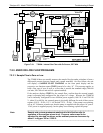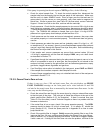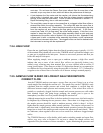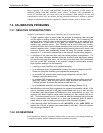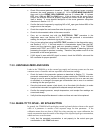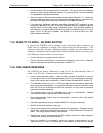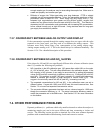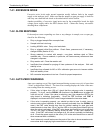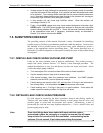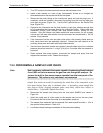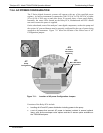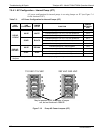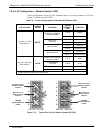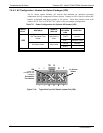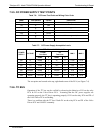
Teledyne API - Model T200H/T200M Operation Manual Troubleshooting & Repair
239
Another reason for high (although not necessarily out-of-range) values for AutoZero
could be the ozone air filter cartridge, if its contents has been exhausted and needs
to be replaced. This cartridge filters chemicals that can cause chemiluminescence
and, if saturated, these chemicals can break through to the reaction cell, causing an
erroneously high AutoZero value (background noise).
A dirty reaction cell can cause high AutoZero values. Clean the reaction cell
according to Section 6.3.5.
Finally,
a high HVPS voltage value may cause excess background noise and a high
AZERO value. The HVPS value changes from analyzer to analyzer and could show
nominal values between 450 and 800 V. Check the low-level hardware calibration
of the preamplifier board and, if necessary, recalibrate exactly as described in
Section 13 in order to minimize the HVP
S.
7.5. SUBSYSTEM CHECKOUT
The preceding sections of this manual discussed a variety of methods for identifying
possible sources of failures or performance problems within the analyzer. In most cases
this included a list of possible causes and, in some cases, quick solutions or at least a
pointer to the appropriate sections describing them. This section describes how to
determine if a certain component or subsystem is actually the cause of the problem being
investigated.
7.5.1. SIMPLE LEAK CHECK USING VACUUM AND PUMP
Leaks are the most common cause of analyzer malfunction; This section presents a
simple leak check, whereas Section 7.5.2 details a more thorough procedure. The
method described here is easy
, fast and detects, but does not locate, most leaks. It also
verifies the sample pump condition.
Turn the analyzer ON, and allow at least 30 minutes for flows to stabilize.
Cap the sample inlet port (cap must be wrench-tight).
After several minutes, when the pressures have stabilized, the SAMP (sample
pressure) and the RCEL (vacuum pressure) readings.
If both readings are equal to within 10% and
less than 10 in-Hg-A, the instrument is
free of large leaks. It is still possible that the instrument has minor leaks.
If both readings are < 10 in-Hg-A, the pump is in good condition. A new pump will
create a pressure reading of about 4 in-Hg-A (at sea level).
7.5.2. DETAILED LEAK CHECK USING PRESSURE
If a leak cannot be located by the above procedure, obtain a leak checker similar to
Teledyne API part number 01960, which contains a small pump, shut-off valve, and
pressure gauge to create both over-pressure and vacuum. Alternatively, a tank of
pressurized gas, with the two stage regulator adjusted to ≤ 15 psi, a shutoff valve and
pressure gauge may be used.
Note Once tube fittings have been wetted with soap solution under a
pressurized system, do not apply or re-apply vacuum as this will cause
soap solution to be sucked into the instrument, contaminating inside
surfaces. Do not exceed 15 psi when pressurizing the system.
07270B DCN6512



